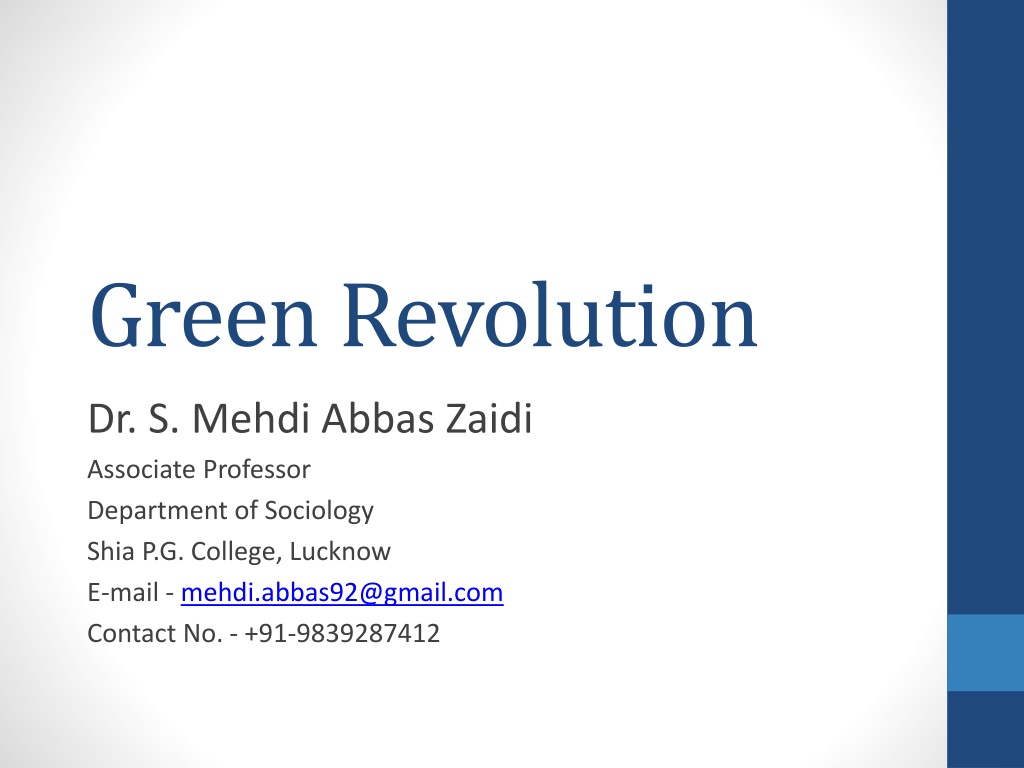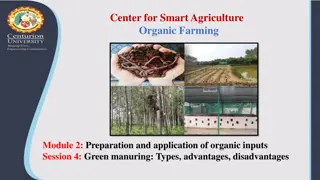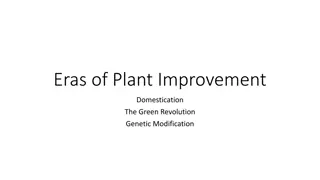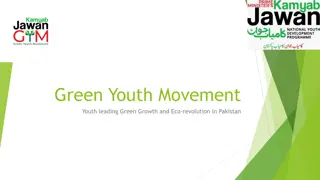Understanding the Green Revolution in India
The Green Revolution in India transformed agriculture into an industrial system through the adoption of modern methods and technologies. Led by Dr. S. Mehdi Abbas Zaidi and driven by figures like M.S. Swaminathan, it began in 1966 and significantly boosted food grain production. However, while it enhanced self-sufficiency, concerns arose regarding environmental impacts like land degradation due to increased use of chemical pesticides and fertilizers.
Download Presentation

Please find below an Image/Link to download the presentation.
The content on the website is provided AS IS for your information and personal use only. It may not be sold, licensed, or shared on other websites without obtaining consent from the author. Download presentation by click this link. If you encounter any issues during the download, it is possible that the publisher has removed the file from their server.
E N D
Presentation Transcript
Green Revolution Dr. S. Mehdi Abbas Zaidi Associate Professor Department of Sociology Shia P.G. College, Lucknow E-mail - mehdi.abbas92@gmail.com Contact No. - +91-9839287412
Green Revolution The Green Revolution in India refers to a period in India when agriculture was converted into an industrial system due to the adoption of modern methods and technology, such as the use of high yielding variety (HYV) seeds, tractors, irrigation facilities, pesticides, and fertilizers. Mainly led by agricultural scientist M. S. Swaminathan in India. Under premiership of Congress leader Indira Gandhi, the Green Revolution within India commenced in 1966, leading to an increase in food grain production, especially in Punjab, Haryana, and Uttar Pradesh.
Continuum Major milestones in this undertaking were the development of high-yielding varieties of wheat, and rust resistant strains of wheat. The introduction of high-yielding varieties (HYV) of seeds and the improved quality of fertilizers and irrigation techniques led to the increase in production to make the country self- sufficient in food grains, thus improving agriculture in India. The production of wheat has produced the best results in fueling self-sufficiency of India.
Continuum Along with high-yielding seeds and irrigation facilities, the enthusiasm of farmers mobilized the idea of agricultural revolution. Due to the rise in use of chemical pesticides and fertilizers, there was a negative effect on the soil and the land (e.g., land degradation).
Practices Under Green Revolution Irrigation infrastructure Use of pesticides Use of insecticides Use of herbicides Consolidation of holdings Land reforms Improved rural infrastructure Supply of agricultural credit Use of chemical or synthetic fertilizers Use of sprinklers or drip irrigation systems Use of advanced machinery Use of vector quantity
Factors Responsible for Implementation of Green Revolution Frequent famines: In 1964 65 and 1965 66, India experienced two severe droughts which led to food shortages and famines among the country's growing population. Modern agricultural technologies appeared to offer strategies to counter the frequency of famines. Lack of finance: Marginal farmers found it very difficult to get finance and credit at economical rates from the government and banks and hence, fell as easy prey to the money lenders. Low productivity: In the context of India's rapidly growing population, the country's traditional agricultural practices yielded insufficient food production.
Consequences The Green revolution had led to the consolidation of the status of the middle peasantry as a dominant class. The upper caste class groups which traditionally dominated was replaced by the middle peasantry or had to compete with them to maintain their traditional status and power. They employed a variety of strategies of cooperation, compromises and confrontation . These set of social forces in rural society led increasingly to social polarization, large scale migration to cities, social tensions. The relationship between the middle class peasantry and the lower castes declined and led to exploitation and violence.
White Revolution White Revolution was one of the biggest dairy development movements, by the Indian Government, in India in 1970. It was a step taken by the Indian Government to develop and help the dairy industry sustain itself economically by developing a co-operative, while providing employment to the poor farmers. The White Revolution helped increase milk productivity and milk was now sold at competitive market prices. This program increased the demand for development and production of healthy animals, use of modern technology in milk production sector and networking between various small and large scale dairy industries.
Continuum The aim of White Revolution was to make India one of the largest milk producers in the world. The White Revolution, known as Operation Flood, was launched in 1970. It was an initiative by India s National Dairy Development Board (NDDB) and was the world s biggest dairy development programme. Operation Flood was based on the experimental pattern set up by Verghese Kurien (Father of White Revolution), chairman and founder of AMUL, who was named the Chairman of NDDB and was also recognised as the architect of Operation Flood.
Yellow Revoltion The revolution launched in 1986- 1987 to increase the production of edible oil, especially mustard and sesame seeds to achieve self-reliance is known as the Yellow Revolution. Sam Pitroda is Known as the father of the Yellow Revolution in India. Yellow Revolution targets nine oilseeds that are groundnut, mustard, soybean, safflower, sesame, sunflower, niger, linseed, and castor. To ensure the success of the yellow revolution India launched Oil Technological Mission in 1986. The Yellow revolution had the implantation of hybrid mustard and sesame seeds which significantly increased the production of edible oil which was also due to the use of improved technology for oil production.
Blue Revolution Blue Revolution also called as Neel Kranti Mission in India was launched in 1985-1990 during the 7th Five-Year Plan. The main objective is to develop, manage, and promote fisheries to double the farmers income. The Blue Revolution is an initiative taken by the government for the growth of the aquaculture industry. The Neel Kranti Mission was the start of the Blue Revolution in India with the vision to achieve the economic prosperity of India keeping in view the sustainability, bio-security, and environmental concerns. The Intensive Marine Fisheries Program was launched, and eventually, the fishing harbours in Vishakhapatnam, Kochi, Tuticorin, Porbandar, and Port Blair were also established over the time.
Reference Lavanya M.M. & Jain S.K., Rural Sociology Singh V.N. & Singh J., Rural Sociology























